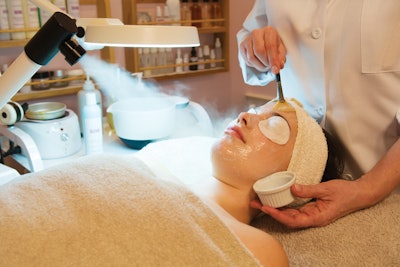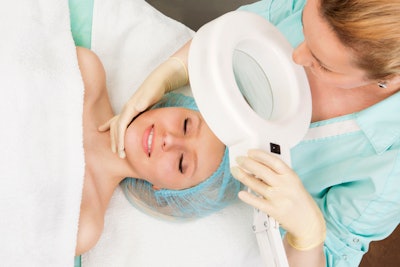 [Images: Getty Images]
[Images: Getty Images]“The more aggressive it is, the more downtime needed.” In addition, aging clients often discount their skin’s slowing ability to heal, points out DermAware founder Gül Zone. “Oftentimes, peels are performed without this consideration, which extends the rate of recovery,” she adds.
All our sources agreed that a series of four to six treatments is always optimal. “Although one chemical treatment will lead to visible rejuvenation, it’s best when estheticians can ‘capture’ the skin as it’s turning over, which generally occurs in two- to three-week intervals,” explains Khalil-Otto. “This encourages the skin cells to regenerate more rapidly, and breaks up melanin before it rises to the surface.”
Zone notes that serial treatment minimizes inflammatory responses. “You’re also able to vary the strength and type of acid used, based on previous responses,” she says. “Plus, the client has to commit to taking care of their skin over time.”
RELATED: Spa Pros Explain Proper Eye Care Treatment
But even when executing the gentlest of chemical peels, it’s crucial to take a client’s skin type into account. This will determine which ingredients to reach for and which ones to avoid, as well as any accompanying skin issues that need addressing before the treatment can take place. Read on for key pointers from leading industry experts.
Dry Skin
If dry skin is due to age, over-exfoliation or simply lack of hydration, it’s important to bring the client’s skin back to optimal health before proceeding with chemical exfoliation, says Khalil-Otto. She recommends restoring barrier function with a blend of humectants and anti-inflammatory ingredients. “Afterward, gentle exfoliation will be key to removing damaged cells and revealing new healthy ones.”
Elizabeth Jones Roth, an advanced instructor at Dermalogica, explains that the cells of dry skin have a harder time with desquamation, leading to hydration loss and roughness. “These clients need gentle exfoliants that reinforce internal hydration,” she says. Zone, who echoes that sentiment, recommends vitamin B and peptide blends.
RELATED: Skincare Experts on the Latest in Topical Delivery Systems
PCA Skin’s vice president of business development, Danae Markland, looks to lactic acid to treat dry skin because “it purges dead skin cells while stimulating healthy new ones, which contain more moisture,” she says.
Dry/ Acneic Skin
Ensure the client’s skin barrier is healthy and intact before using any exfoliant, says Roth, who also reminds estheticians to consider any acne medications the client could be taking (such as Accutane). “Oily skin often produces four to five times more skin cells than average, resulting in a buildup of dead cells,” she says.
Salicylic acid, a beta hydroxy acid found in some chemical peel blends, helps reduce such keratolytic buildup by penetrating oil-filled pores. It also has anti-inflammatory and antibacterial properties, which can do wonders to lessen breakouts.
Khalil-Otto points out that even the oiliest skin types need hydration, “especially when using chemical exfoliation products.” Therefore, in addition to tried-and-true salicylic acid and benzoyl peroxide, she prefers to use lightweight products during the service that feature hyaluronic acid and other nourishing ingredients. “Combine chemical exfoliation with a daily product containing skin-loving antioxidants, retinol, glycolic acid and vitamin C,” she suggests.

“The first step to addressing sensitive skin is to normalize hydration levels with humectants, then seal them in with occlusive agents in conjunction with anti-inflammatory ingredients,” says Khalil-Otto. Throughout treatment, it’s essential to check in with sensitive clients to make sure their skin isn’t being overstimulated, says Markland, who adds that the optimal percentages of lactic acid and trichloracetic acid (TCA)—up to 20 percent of the former and 10 percent of the latter—can offer superficial moisturizing benefits when blended with anti-inflammatory agents such as linseed oil.
Remember, acids can be too irritating for this skin type. Zone recommends peels enriched with vitamins A and C, and Roth points to alternative, less harsh agents— specifically, enzymes such as papain (papaya), bromelain (pineapple) and pumpkin.
RELATED: Proper Skin Cleansing Advice For Your Clients
“Enzymes digest and break down dead keratin proteins, which sloughs off gently, bringing healthy new cells to the surface and neutralizing the enzymes,” she explains. “This reduces the risk of over-exfoliation.”
Hyperpigmented Skin
Stubborn pigmentation often requires a few treatments to lift and reveal even skin tones. “To reach the basal layer where melanocyte cells are produced, I recommend TCA, one of the strongest acids,” shares Roth. “Used in layers, it can penetrate to achieve various depths of peeling.” To complement the TCA and boost results, the pro reaches for an alpha hydroxy acid, which brightens, hydrates and exfoliates.
In addition to chemical peels every four to six weeks, Khalil-Otto recommends that hyperpigmented clients cycle on and off a homecare hydroquinone product every two months. “Resorcinol is also an effective flaking agent that encourages a little more peeling and accelerates results,” says Markland. For clients seeking gentler, more natural lightening agents, suggest products containing kojic acid and vitamin C.
For anyone expecting a quick fix, education and expectation management are key. “Success depends on determining the cause of the hyperpigmentation and how long it’s been an issue,” explains Khalil-Otto. “Once a stasis or leveling-off is achieved, it’s imperative to use topical lighteners to slow down, maintain and prevent further pigmentation.”
Mature Skin
The aging process slows cellular turnover and depletes collagen, but chemical peels can help hasten cell regeneration, improve texture and tone, build collagen and otherwise combat Father Time. “As long as skin is healthy and not too thin, I like to use glycolic peels,” says Zone.
Markland recommends TCA for its ability to mitigate the appearance of fine lines and wrinkles. If an older client’s skin is looking particularly dull, she turns to brightening agents and antioxidants.
To this end, Roth recommends vitamin A. “This speeds cell renewal and smooths out rough texture, and inhibits collagen- degrading enzymes,” she explains. Retinoic acid receptors naturally occur in our skin, but they decrease as we age, making our skin more sensitive to retinol.
However, Roth says that with a gradual increase in concentration, those receptors can be restored. “For best results, deliver retinol-based peels later in the day, as the ingredient can be very sensitive to light and air,” she advises, adding that such treatments should always be paired with SPF.
For thicker and heavier-to-penetrate skin, Khalil-Otto recommends layering with multiple passes. “I typically provide an application add-on to the neck, chest and hands too—since those areas also tend to give away a client’s age,” she reports.

Young Skin
Chemical peels can help teens and young adults control acne/acne scarring, minimize pores and even out skin tone—so they won’t need such invasive treatments later in life. “Look for TCA, kojic acid, azelaic acid and antioxidant- enriched formulas,” says Markland, who recommends peels that address dullness and overall skin health.
Roth likes to send young clients home with light scrubs enriched with hydroxy acids, so as to maximize cell turnover. Zone prefers using lactic and enzyme peels on young skin, and notes that these guests often don’t adhere to post- peel homecare recommendations—another reason to go gentle. With this group, SPF and client compliance is key, stresses Khalil-Otto. “Education will set them up for skincare success for years to come—and create loyal, lifelong clients,”
she says.
Know Before You Peel
Chemical exfoliation contraindications include pregnancy, breastfeeding, ingredient allergies, inflamed skin with open wounds, psoriasis, sunburn, recent wax or laser treatments, immune disorders and chemotherapy/ radiation. And make sure guests haven’t taken aspirin that day. “As a derivative of salicylic
acid, it can lead to serious complications,” says Elizabeth Jones Roth, an advanced instructor at Dermalogica, adding that clients on Accutane or Retin-A should not receive peels, as these ingredients affect the skin’s ability to heal.
Patch tests are crucial. Review client allergies and sensitivities prior to performing any chemical service—especially a series. “Health status, medication and lifestyle can change in a matter of weeks,” notes Marya Khalil- Otto, CEO of VI Aesthetics, “so perform a thorough client intake during each visit to check for contraindications that may arise between treatments.” And if you’re unsure whether a new development could be a potential contraindication? “My motto is ‘When in doubt, refer out,’” says Khalil-Otto. “The best course of action is always to send the client back to their doctor for a final sign-off.”
– by Katie O’Reilly











